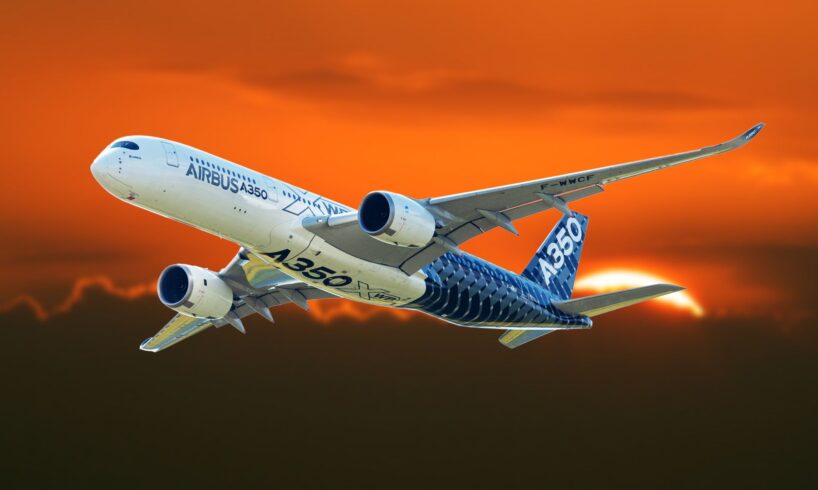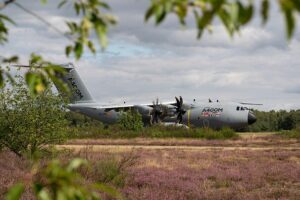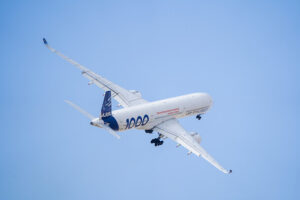
The Airbus A350 is one of the most modern passenger aircraft in the skies today. Since entering commercial service in 2015, the aircraft has proven immensely popular with both airlines and passengers around the world, with its low operating costs and impressive sustainability credentials giving it a leading edge in a crowded market.
Passengers onboard and those living close to major airports will also be glad to know that the Airbus A350 is one of the quietest widebody aircraft ever produced. In this article, we take a closer look at what makes the A350 so quiet, as well as a broader look at the A350’s role in global passenger aviation today and the legacy it has made in its relatively short time in commercial service.
Advanced Engine Design
One of the main reasons why the Airbus A350 is so quiet is thanks to its engines. The A350 is powered by two Rolls-Royce Trent XWB engines, which are among the quietest and most fuel-efficient commercial aircraft engines ever built. Each engine provides the aircraft with a take-off thrust of 97,000 lbf.
But how did Rolls-Royce make such large, powerful engines that are so quiet? The Trent XWB’s large fan diameters work more efficiently and more quietly, and they have a lower fan tip speed, which helps to reduce noise further. In addition, the engine’s shape and nacelles have been specifically designed to manage airflow and suppress noise.
The Airbus A350’s Aerodynamic Body
The Airbus A350’s curved, aerodynamic body also contributes significantly to its lower-than-average levels of noise pollution. The aircraft’s smooth wing shape and unique winglets replicate those of birds, and both help to reduce drag over the aircraft’s surface, therefore reducing noise levels too. It makes sense for aircraft manufacturers such as Airbus to be looking to birds for wing design inspiration – after all, birds have been flying for much longer than aircraft have!
Around 70% of the Airbus A350’s body is made of lightweight composite materials, primarily CFRP (carbon-fiber reinforced plastic, which is made from carbon fibers bound with plastic resin). It is stronger than iron, lighter than aluminum, and more corrosion-resistant than both materials. Not only does this save weight (and therefore the amount of fuel consumed – a major plus for both the environment and airlines alike), it also reduces vibrations and noise as the aircraft moves swiftly through the air.
Cabin Soundproofing & Noise Reduction Technologies
The Airbus A350 boasts noise-reducing chevrons on the exterior of its two Rolls-Royce Trent XWB engines, as well as acoustic lining on the inside, which helps absorb some of the noise that would otherwise be emitted into the atmosphere. The design of the Airbus A350’s landing gear and flaps also helps to limit the noise emitted by the aircraft.
And it is not just on the outside that the Airbus A350 is quieter than most other aircraft of a similar size. Inside the cabin, sound insulation materials help to dampen engine noise, resulting in a spectacularly quiet experience for the passengers onboard. As with all aircraft, those sitting in front of the engines will enjoy the quietest experience, which is the reason why the vast majority of premium cabins, such as business class and premium economy, are located towards the front of the aircraft.
At cruise altitude and speed, the cabin noise level onboard an Airbus A350 is often below 60 decibels, making it a very quiet aircraft. For comparison, the noise level onboard a Boeing 787 is around 60-62 decibels. The Airbus A380 comes in slightly higher at approximately 62-65 decibels, although that is to be expected, given that the so-called Superjumbo is powered by four engines rather than two.
Despite its much smaller size, the Boeing 737 is significantly louder than the Airbus A350, with average noise level measurements of around 65-70 decibels when flying at cruising altitude and speed. That should not come as a surprise either, given the much older technology and design features found onboard the 737.
All of these features help the Airbus A350 to have a remarkably small noise footprint when compared to older widebody aircraft such as the Boeing 747. On its website, Virgin Atlantic displays the noise footprint of an A350 compared to a 747 around its hub at London Heathrow Airport (LHR):
The latest data from ch-aviation shows that Virgin Atlantic has 12 Airbus A350s in its fleet, all of which are the A350-1000 variant. The carrier operates a number of lower-capacity, premium-heavy A350-1000s on routes that can accommodate a larger business class, such as London Heathrow Airport (LHR) to New York John F. Kennedy International Airport (JFK). These aircraft can accommodate a total of 335 passengers. Virgin Atlantic also operates a smaller number of higher-density A350-1000s, which can carry up to 397 passengers. The carrier deploys these aircraft on leisure-oriented routes, such as Manchester Airport (MAN) to Orlando International Airport (MCO).
When it comes to how pilots feel about the Airbus A350 being so quiet, let’s head over to Hong Kong International Airport (HKG), the home base of Cathay Pacific. In a recent interview, Cathay Pacific Captain Evan Summerfield detailed their favorite things about flying the Airbus A350, with its low noise levels coming out on top. Summerfield said,
“The Airbus A350 is noticeably quieter than other aircraft in the cruise, and I particularly notice it when coming into land through horrible weather. It’s raining and you’re being battered around a bit on approach, but on the flight deck you can talk at normal conversation levels. It’s quiet for passengers too – and this is great because one of the things that adds to jet lag and fatigue is noise. Reduce the noise, and you ‘arrive in better shape’, to use an old Cathay Pacific slogan.”
Cathay Pacific has a total of 48 Airbus A350s in its fleet, made up of 30 A350-900s and 18 of the larger A350-1000. The oneworld carrier’s A350-900s can accommodate up to a maximum of 280 passengers in a three-class configuration – 38 in business class, 28 in premium economy, and 214 in economy class. Meanwhile, Cathay Pacific’s A350-1000s can carry up to a total of 334 passengers – 46 in business class, 32 in premium economy, and 256 in economy class.
About The Airbus A350
The Airbus A350 entered commercial service in January 2015 with Qatar Airways, and soon became a firm favorite with airlines and passengers around the world thanks to its low operating costs and superior passenger comforts. To date, Airbus has built and delivered more than 600 Airbus A350s, with Singapore Airlines being the largest operator.
The Star Alliance carrier deploys its fleet of 65 Airbus A350s (including seven of the custom-designed A350-900ULRs) on some of the world’s longest routes. Currently, Singapore Airlines flies non-stop between its hub at Singapore Changi Airport (SIN) and New York John F. Kennedy International Airport (JFK), as well as to nearby Newark Liberty International Airport (EWR).
The Airbus A350 plays a crucial role in Singapore Airlines’ global route network, with the carrier also using the aircraft on shorter routes throughout the Asia-Pacific region, flying to destinations such as Hyderabad Rajiv Gandhi International Airport (HYD), Male Velana International Airport (MLE), and Bangkok Suvarnabhumi International Airport (BKK).
Meanwhile, in North America, the largest operator of the Airbus A350 is Delta Air Lines, with the SkyTeam carrier deploying the aircraft on routes including Hartsfield-Jackson Atlanta International Airport (ATL) to Johannesburg O. R. Tambo International Airport (JNB). Delta Air Lines currently flies just the A350-900 variant but has placed an order for the larger -1000 too, expecting its first deliveries in 2026.
An Aircraft Fit For The Future
The Airbus A350 is quiet because almost every major noise source, namely the engines, fuselage, and cabin, has been engineered for noise reduction, both for passenger comfort and environmental compliance. Airbus has future-proofed the A350 thanks to its modern design, low operating costs, and impressive sustainability credentials. Overall, the A350 is a perfect example of how modern aircraft design prioritizes both efficiency and comfort.






